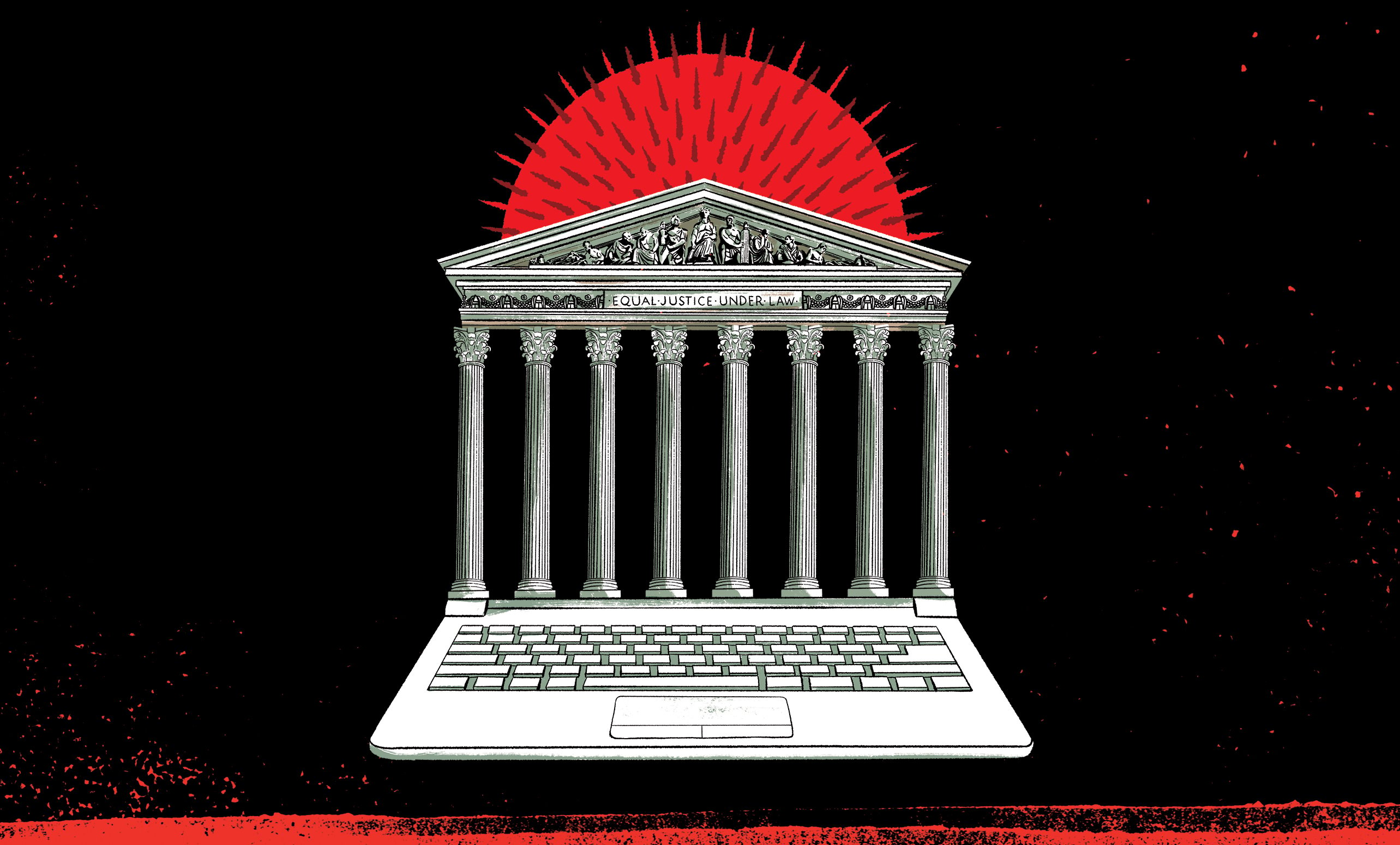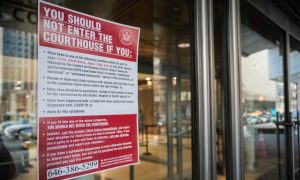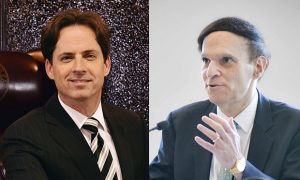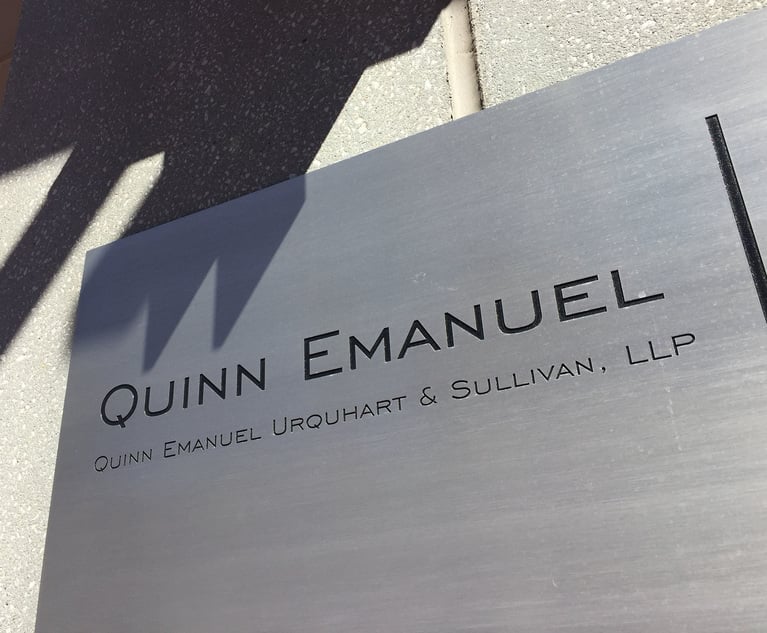In the Pandemic, State and Federal Judges Lean on Technology
Across territories and time zones, jurists find new ways to hear cases and conduct business.
April 22, 2020 at 11:30 AM
9 minute read

Judge Roy Ferguson is the only judge in a five-county judicial district in western Texas. The district covers about 20,000 square miles of very rural territory—including over 400 miles of shared border with Mexico, 25,000 residents and two time zones.
"I'm a general jurisdiction judge," said Ferguson, who was first elected judge of the 394th Judicial District in 2012 and was reelected in 2016. "In Texas, the district court is the highest trial-level court. I handle all felony criminal charges, all family law, real estate disputes, disputes of high dollar amounts.
"It is a busy job because there's just one of me. I'm also in charge of administrative functions. We wear all the hats."
Roughly 2,000 miles north, in New York—the epicenter for the coronavirus in the U.S.—Chief Judge Robert Katzmann has overseen the U.S. Court of Appeals for the Second Circuit, which includes New York, Connecticut and Vermont, since 2013.
 Sign outside of the New York City courthouses warning against people with coronavirus symptoms to enter the courts. Photo: Ryland West/ALM
Sign outside of the New York City courthouses warning against people with coronavirus symptoms to enter the courts. Photo: Ryland West/ALMThe Second Circuit, with 13 judgeships, has a reputation as one of the largest and most influential federal appellate courts, particularly in the areas of securities and antitrust law. Katzmann, who recently authored "Judging Statutes," a book on statutory interpretation, is well-known for his scholarship and work in both civic education and legal assistance for immigrants.
From the Lone Star State to the Empire State, judges are finding common ground in technology as the key to keeping their courts on pace, and their staffs, lawyers and clients safe during the nation's public health crisis. And they predict the use of that new technology will not fade with the pandemic, but will likely permanently change the operation of judicial systems.
A Necessary Resource
The Second Circuit's approach to the crisis is typical of most of the federal circuit courts. The court is hearing all oral arguments using a teleconference platform, and those arguments are audio livestreamed. As an alternative, the parties may ask to submit the appeal for decision on the briefs.
"Without the technological capacity, we cannot be hearing remote arguments. We could not be having filings electronically in a smooth way," Katzmann said. "We're able to do what we're doing really because of technology. … Coming out of this, I think that we will all need to step back and rethink and make sure our technological capacity can meet any challenge."
Other federal circuits are giving their judges the discretion to decide whether to postpone arguments, hear them telephonically or decide appeals on the briefs. The Federal Circuit recently announced that, for the first time in its history, it will provide live audio access of its telephonic arguments. The U.S. Court of Appeals for the Ninth Circuit has long been ahead of its sister circuits in using videoconferencing and livestreaming of certain arguments.
Federal and state trial courts generally have suspended all jury trials. Their judges by and large have been given discretion to use technology to limit in-person courtroom appearances. The recent CARES Act, passed by Congress to address the needs of businesses and workers during the pandemic, permits federal courts to use audio and video conferences for criminal cases, including guilty plea and sentencing hearings in misdemeanor and felony cases.
The Act gives the expanded authority to chief district court judges and will end 30 days after the date on which the national emergency ends, or the date when the Judicial Conference of the United States finds that the federal courts are no longer materially affected, whichever is earlier.
 Texas Supreme Court justices hold a court conference through Zoom on March 27.
Texas Supreme Court justices hold a court conference through Zoom on March 27.In the Second Circuit, telephonic arguments, which the court started on March 23, have been "smooth," Katzmann said.
"We have the advantage of being a three-judge court," he said. "We were going to have en banc arguments on May 11 or 12, and we moved it Sept. 24. That was our one concession. At this point, the judges are pretty technically proficient at reading cases online and doing research with databases. They've been able to function pretty well. The opinions and orders keep being churned out. If you didn't know there was a crisis, you would see a court functioning pretty much the way it has always functioned."
In the D.C. Circuit, the initial foray into telephonic arguments March 20 was "rough," one D.C. Circuit judge said, when one judge's audio went silent and another judge was dropped from the call for five to six minutes. But things have improved since.
"We've done four to five sittings on teleconference," the judge added. "The initial one was rough but it has worked pretty darn well. The idea that at the drop of a hat we're going to switch everything is kind of fantasy land."
The U.S. Supreme Court in March postponed the last two argument sessions of the term but, on April 13 announced that it will hold arguments in select cases by teleconference on six days in May, with a live audio feed to the media. The justices have long been opposed to any type of video rendition of oral arguments and they have resisted, with only a few exceptions, even providing same-day audio of the arguments as well.
'Evolution Can Be Painful'
Not surprisingly to state court judges, like Ferguson, the federal courts seem to be taking baby steps into the technology that can help them to continue most of their functions.
"Sometimes evolution can be painful, and this is one of those times," Ferguson said. "People get mired in ways things already have been done. That can be an impediment to advancement. We are now quickly realizing the advantages of incorporating this technology into our everyday work."
With the advent of the coronavirus and the Texas governor's disaster declaration, Ferguson said, judges who already were comfortable with digital solutions because of mandatory e-filings had to figure out how to mirror a courtroom hearing virtually.
"We worked weeks ago with OCA (Office of Court Administration) on what system works best," he recalled. "When this first started to happen, I received a call from OCA, saying, 'We want to get ahead of this.' Within 48 hours a plan was in place. The OCA acquired a license for every judge in Texas—3000—at no cost to implement Zoom virtual hearings immediately."
 Left, Judge Roy Ferguson of the 394th Judicial District Court of Texas. Right, Chief Judge Robert A. Katzmann of the U.S. Court of Appeals for the Second Circuit. (Photo by David Handschuh/NYLJ)
Left, Judge Roy Ferguson of the 394th Judicial District Court of Texas. Right, Chief Judge Robert A. Katzmann of the U.S. Court of Appeals for the Second Circuit. (Photo by David Handschuh/NYLJ)Statutory provisions prohibiting certain elements of virtual hearings were lifted by emergency orders from the state supreme court. "That enabled us to hold those hearings virtually wherever we are," he added. "That was really the defining moment."
Ferguson, who uses Twitter to offer many tips on the use of Zoom, worked in a small group to refine the Zoom platform software for the needs of lawyers and their clients. "Once you get past the fear, it just becomes another litigation skill," he said. "You just have to learn how to use the system. Judges have embraced it and are working very hard across the state to do this job well. We've probably had 15,000 hearings using Zoom."
And because the Texas Constitution requires that courts be open to the general public, with very few exceptions, in order to comply with that requirement during the COVID-19 crisis, virtual hearings are streamed live to YouTube.
But one federal appellate judge injected a note of caution. "To the extent people want to try new technology, say, videoconferencing, it's tricky to implement because of security and you can't do onsite training," he said. "What do you do with a 75-year-old judge who needs a camera hooked up to a laptop at home? It's a fraught time to try to innovate. The teleconference mechanism is there. But doing something beyond that? People say just use Zoom, but you can just do Zoom."
The nine-member Texas Supreme Court began hearing arguments using Zoom in April.
What's Next?
Looking ahead, Katzmann said federal courts must do all they can to ensure that their systems are as safe as they can be. "If you take down the systems through some sort of failure in technology or even a cyberattack, the whole system will not function," he warned. "That's the big takeaway."
And the question for all of us, he added, is, "If we continue as a society to all be on technological devices, do we have the capacity to do all we need to do?"
Ferguson believes elements of what judges and lawyers are learning now from technology in the crisis will be incorporated into the practice of law and the courts.
For example, if the lack of broadband availability in rural areas could be solved, virtual hearings, in particular, he said, "truly could revolutionize access to justice for rural areas where there are no lawyers or people can't afford them. We've been doing pro bono pushes and everything bars could think of to try to close that gap. This may be a game-changer."
This content has been archived. It is available through our partners, LexisNexis® and Bloomberg Law.
To view this content, please continue to their sites.
Not a Lexis Subscriber?
Subscribe Now
Not a Bloomberg Law Subscriber?
Subscribe Now
NOT FOR REPRINT
© 2025 ALM Global, LLC, All Rights Reserved. Request academic re-use from www.copyright.com. All other uses, submit a request to [email protected]. For more information visit Asset & Logo Licensing.
You Might Like
View All
Private Equity Giant KKR Refiles SDNY Countersuit in DOJ Premerger Filing Row
3 minute read
Skadden and Steptoe, Defending Amex GBT, Blasts Biden DOJ's Antitrust Lawsuit Over Merger Proposal
4 minute read
Quinn Emanuel Files Countersuit Against DOJ in Row Over Premerger Reporting
3 minute read
Read the Document: DOJ Releases Ex-Special Counsel's Report Explaining Trump Prosecutions
3 minute readTrending Stories
Who Got The Work
J. Brugh Lower of Gibbons has entered an appearance for industrial equipment supplier Devco Corporation in a pending trademark infringement lawsuit. The suit, accusing the defendant of selling knock-off Graco products, was filed Dec. 18 in New Jersey District Court by Rivkin Radler on behalf of Graco Inc. and Graco Minnesota. The case, assigned to U.S. District Judge Zahid N. Quraishi, is 3:24-cv-11294, Graco Inc. et al v. Devco Corporation.
Who Got The Work
Rebecca Maller-Stein and Kent A. Yalowitz of Arnold & Porter Kaye Scholer have entered their appearances for Hanaco Venture Capital and its executives, Lior Prosor and David Frankel, in a pending securities lawsuit. The action, filed on Dec. 24 in New York Southern District Court by Zell, Aron & Co. on behalf of Goldeneye Advisors, accuses the defendants of negligently and fraudulently managing the plaintiff's $1 million investment. The case, assigned to U.S. District Judge Vernon S. Broderick, is 1:24-cv-09918, Goldeneye Advisors, LLC v. Hanaco Venture Capital, Ltd. et al.
Who Got The Work
Attorneys from A&O Shearman has stepped in as defense counsel for Toronto-Dominion Bank and other defendants in a pending securities class action. The suit, filed Dec. 11 in New York Southern District Court by Bleichmar Fonti & Auld, accuses the defendants of concealing the bank's 'pervasive' deficiencies in regards to its compliance with the Bank Secrecy Act and the quality of its anti-money laundering controls. The case, assigned to U.S. District Judge Arun Subramanian, is 1:24-cv-09445, Gonzalez v. The Toronto-Dominion Bank et al.
Who Got The Work
Crown Castle International, a Pennsylvania company providing shared communications infrastructure, has turned to Luke D. Wolf of Gordon Rees Scully Mansukhani to fend off a pending breach-of-contract lawsuit. The court action, filed Nov. 25 in Michigan Eastern District Court by Hooper Hathaway PC on behalf of The Town Residences LLC, accuses Crown Castle of failing to transfer approximately $30,000 in utility payments from T-Mobile in breach of a roof-top lease and assignment agreement. The case, assigned to U.S. District Judge Susan K. Declercq, is 2:24-cv-13131, The Town Residences LLC v. T-Mobile US, Inc. et al.
Who Got The Work
Wilfred P. Coronato and Daniel M. Schwartz of McCarter & English have stepped in as defense counsel to Electrolux Home Products Inc. in a pending product liability lawsuit. The court action, filed Nov. 26 in New York Eastern District Court by Poulos Lopiccolo PC and Nagel Rice LLP on behalf of David Stern, alleges that the defendant's refrigerators’ drawers and shelving repeatedly break and fall apart within months after purchase. The case, assigned to U.S. District Judge Joan M. Azrack, is 2:24-cv-08204, Stern v. Electrolux Home Products, Inc.










